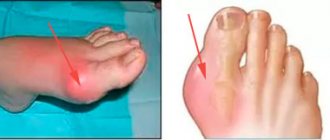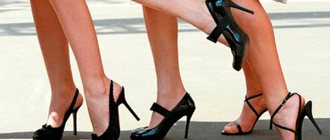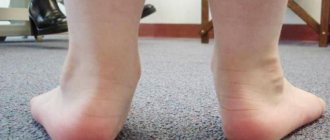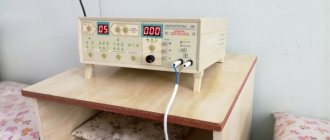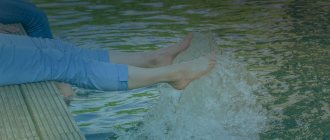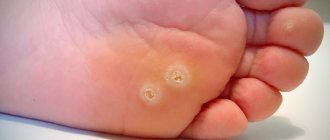From this article you will learn:
- Causes of hallux valgus deformity
- Diagnosis of the stage of the disease
- Non-surgical methods for treating foot deformities
- Exercise therapy and special devices for non-surgical treatment of foot deformities
Non-surgical methods for treating foot deformities (in other words, bunions) are most effective at the initial stage of the disease. Such a deformity is called valgus, and it is expressed in the curvature of the metatarsophalangeal joint of the big toe. A protruding bump is not only an aesthetic discomfort, it can interfere with walking, cause skin damage in the form of calluses and abrasions, and even cause arthrosis, varicose veins or flat feet.
In complex cases, only surgical intervention, which is accompanied by a long recovery, can cope with hallux valgus deformity. In order to prevent the development of the disease and not limit your movement during the period of postoperative rehabilitation, you need to diagnose the deformity in a timely manner and resort to non-surgical treatment methods.
Causes of hallux valgus deformity
The problem is faced most often by women (97–99%), who are 30 years of age or older. This is a common pathology of the foot, it is in second place after flat feet. Due to progressive deformation, a person is deprived of full movement. In addition, if you have this disease, the choice of shoes is limited, wearing them is uncomfortable or painful.
Recommended articles on the topic:
- How to massage the abdomen for weight loss: different techniques for health and beauty
- Stone massage: description, benefits, methods
- MRI of three parts of the spine: when is it necessary and what are the features of the procedure
The main causes of the defect:
- Uncomfortable shoes (toe too narrow or high heel).
- Having flat feet. A normal foot has a transverse and longitudinal arch; they are formed and supported by a muscle-tendon corset. Thanks to the arches, the foot is cushioned while walking, preventing deformation of the bone and joint structures. If the muscle musculature is weakened, flattening of the foot occurs. As a result, the osteoarticular apparatus begins to experience heavy loads, which leads to deformation.
- Heredity. The deformity occurs due to a genetic predisposition to diseases of the musculoskeletal system, lack of calcium (leads to osteoporosis), lack of vitamin D (cause of rickets), uric acid (promotes the appearance of gout). There is also a hereditary specificity in the structure of the feet, when the length of the first metatarsal bone is greater than the others, its inclination is changed or the joint is very mobile.
- Work related to ballet and dance. A ballerina's pointe shoes are smaller than her usual shoes. Therefore, the foot is forced to bend in order to be able to rest on the toes. The socks, whose area is only 2 cm2, support the entire body weight. As a result of dance activities, ballerinas' feet inevitably become deformed.
- Old age, in which there is a reduction in the production of estrogen, which is responsible for slowing down the destruction of bone tissue. Without estrogen, bones begin to rapidly lose calcium, which leads to osteoporosis.
- Excess body weight. Because of this, the load on the feet increases.
- An injured foot in which the configuration is disturbed and the fixing structures are damaged.
- Inflammation of the joints (arthritis), leading to a change in their structure (the process of valgus deformation of the foot is aggravated).
Rehabilitation period after surgery
On the first day, the patient is recommended to remain in the clinic under the supervision of a surgeon. The patient is fitted with special orthoses - Baruk boots, which, when walking, relieve the load from the forefoot and toes on the heel. These shoes must be worn for at least 6 weeks. In a difficult situation, you can additionally rely on crutches and limit physical activity.
After surgery, for 2 weeks it is recommended:
- bed rest;
- place a pillow or cushion under your feet to stimulate the outflow of excess fluid;
- for severe pain, apply cold compresses for 30 minutes up to 4 times a day.
To reduce pain, the doctor selects medications individually and calculates the dosage for home use. Swelling begins to decrease on the 3rd–5th day after surgery. After 14 days, it is recommended to visit the surgeon again to remove the skin sutures.
After 6 weeks, the patient is sent for a repeat x-ray. With pronounced positive dynamics and the absence of contraindications, walking without corrective orthoses with a load on the toes is allowed.
In some older patients, swelling may persist for a long time, which is associated with decreased tone of the veins of the extremities. In such a situation, lymphotropic therapy and contrast foot baths are prescribed.
Diagnosis of the stage of the disease
There are 3 degrees of the disease, which can be distinguished by the manifestations of symptoms and the appearance of the foot.
- Initial (moderate). The patient complains of discomfort when wearing shoes, which manifests itself in skin friction and the formation of calluses on the outer edge of the first metatarsophalangeal joint. A lump appears with redness and swelling of nearby tissues. Regular aching pain is often observed in the foot area. The radiograph shows a valgus angle of less than 20°.
- Average. Arthritis (inflammation of the joint) with characteristic redness of the skin is observed. The pain intensifies. External examination shows the displacement of the second finger to the first. Corns form in areas under the second and third fingers. The angle of valgus deviation increases to 20–40°. The x-ray shows subluxation of the 1st metatarsophalangeal joint.
- Launched. There is pain throughout the entire foot, and movement while wearing shoes becomes constrained. In many cases, patients become unable to work. The foot is significantly deformed. There is a strong displacement of the first finger, which ends up above or below the second. A large bony protrusion forms at the base of the first toe. The skin tissue under the second and third fingers becomes rough, and corns and calluses form. The radiograph shows that the valgus angle exceeds 40 ͦ. Subluxation or dislocation of the 1st metatarsophalangeal joint is clearly visible.
Consultation with a specialist is required for the following changes:
- swelling has appeared at the base of the thumb;
- the protruding bone is red and painful;
- the finger deviates outward;
- legs get very tired when walking;
- swelling is observed;
- Painful calluses and corns form on the soles.
If you have problems with foot deformities, you should consult an orthopedic doctor. During the initial examination, he will find out what the deviation of the thumb is, what condition the blood vessels are in, whether there are calluses, corns, and whether pain is felt in the joint. In addition, the doctor will evaluate the degree of mobility of the foot. To make a diagnosis, one examination is not enough; additional examination is necessary: x-ray in 3 projections, MRI, computer plantography.
The disease can be treated non-surgically only in the initial stages (1–2) with a deviation angle of no more than 20 ͦ. A variety of braces, orthopedic shoes, physical therapy exercises, and medications help well. The surgical method is indicated if the angle of deviation of the fingers exceeds 20 ͦ, the pain is constant, there is a disturbance in gait, and the protruding joint is motionless.
Conservative treatment of hallux valgus is contraindicated in the following cases:
- The presence of varicose veins, thrombophlebitis.
- Open, unhealed wounds on the feet.
- The patient experiences intolerance to fixing materials.
- Allergic reactions to medications were detected.
Caution should be exercised when prescribing treatment for patients with diabetes mellitus, obliterating endarteritis (the feet are vulnerable and require special care).
Complications manifest themselves in increased pain, decreased mobility of the feet, deformation of the fingers, pathology of the knee and hip joints, and gait disturbances.
If the patient does not adhere to the orthopedist's recommendations, this may provoke progression of the disease. Then surgical intervention is inevitable.
Bumps on 2-4 toes
Bunions on the 2nd to 4th toes are the result of hammertoes, claw toes, and mallet toes. Distinctive features:
- it is always formed by the head of the proximal or distal phalanx of the finger and bone growths. Sometimes the volume of the “bone” increases due to inflammation of the soft tissues;
- it is always located on the dorsum of the finger in the area of the proximal or distal interphalangeal joints;
| Hammertoe deformity, top and side view of the foot |
Non-surgical methods for treating foot deformities
The conservative method is aimed at:
- Eliminating the reasons why the foot is curved.
- Correction of limb deformities.
- Relief of symptoms accompanying the disease (pain, inflammation, swelling).
After a certain time, if positive dynamics are observed, the bone stops growing, its size decreases, which leads to normalization of the condition of the foot as a whole. Provided you follow all the specialist’s instructions, you can achieve proper distribution of the load on the foot.
If the patient contacts the doctor for the first time, he will be thoroughly examined. This is necessary to prescribe the most effective course of treatment procedures.
The most common diagnostic methods used to study pathology:
- visual inspection of the deformed limb;
- X-ray examination to identify all bone changes;
- CT, MRI;
- computer plantography, which determines the degree of load on certain areas of the foot.
Having studied and analyzed the results obtained in detail, the orthopedic doctor prescribes the optimal conservative treatment for the patient. Important factors influencing the choice of certain methods are:
- patient's age (usually 50 years and older);
- valgus angle (should not be more than 30°);
- absence of other foot pathologies.
Today, a number of fairly effective non-surgical methods for treating deformities have been developed. Often, in order to achieve positive results, several medical approaches and medications are used at once.
The following conservative methods have shown good results in the fight against hallux valgus:
- Drug therapy.
- Use of special instruments and devices.
- Various therapeutic measures.
- Use of traditional medicine.
To obtain a long-term positive effect, an integrated approach is important, in which all known methods of therapy are harmoniously combined.
In order to eliminate the negative symptoms accompanying foot deformation, drug treatment is successfully used. To stop the inflammatory process, drugs containing hormones (Diprospan, Hydrocortisone) are injected into the joint cavity. In addition to hormonal agents, topical anti-inflammatory agents are used for the same purpose. Painkillers such as ibuprofen and paracetamol are good for treating pain.
There are negative factors that aggravate the disease, which are recommended to be excluded. These include:
- excess weight;
- wearing uncomfortable high-heeled shoes;
- professional activities associated with prolonged stress on the legs (teacher, salesperson, hairdresser).
Therefore, for a quick recovery, it is important to choose comfortable shoes, walk barefoot more, reduce the load on your feet if possible, and strictly follow the doctor’s recommendations.
- Bandages and valgus splints
These devices are worn constantly and only at night. Bandages and valgus splints are made of silicone, plastic, or made of elastic fabrics. The principle of operation of the splint: a special pad fixes the thumb in the desired position and puts pressure on the protruding bone.
The function of the bandage is to reduce the load on the feet, relieve pain, make walking easier, and protect the bones from subsequent bending.
We recommend
Anti-wrinkle facial massage: 10 effective techniques Read more
- Sinusoidal Modeled Currents (SMC)
Physiotherapeutic method. Operating principle: electrodes are attached to the legs, through which an electrical discharge is supplied to the muscles and ligaments. The procedure is safe and does not cause pain. Thanks to the effects of SMT, nerve endings are stimulated, tissue tone increases, blood circulation improves, and swelling is eliminated.
- Medicines
Prescription of medications is required to relieve pain, inflammation, and swelling. Drug therapy is carried out using tablets, injections, ointments, and gels. Ibuprofen, Ketanov, Diclofenac, Indomethacin and other non-steroidal anti-inflammatory drugs are used in treatment. If the pain is severe, the doctor prescribes the injection of hormonal drugs into the joint cavity.
- Splint and orthoses
These devices are used if it is necessary to rigidly fix the leg. With the help of a splint made of durable plastic, the joint becomes immobile.
There are 2 types of orthoses: non-stress (they are used at night, as they do not allow movement) and functional (you can actively move in them). For each specific patient, an individual impression is made, according to which the device is made.
A good home remedy for feet is foot baths. The water in them should be warm (37–38 oC). The procedure is performed in no more than 15 minutes. The various compositions of the baths usually include salt, iodine, pine or herbal infusions. The course lasts 1–2 weeks.
To reduce the bone, traditional medicine is used. Various lotions, compresses containing propolis, turpentine or clay, iodine mesh, baths with a decoction of potato peels or laundry soap are effective.
We recommend
Therapeutic massage for the back: features, indications and contraindications Read more
Thermal treatment methods include paraffin or ozokerite foot wraps. This allows you to improve blood microcirculation, restore the supply of nutrition to muscle tissue, and relieve fatigue.
Exercise therapy and special devices for non-surgical treatment of foot deformities
Therapeutic exercises and foot massage are effective measures aimed at relieving muscle tension and strengthening ligaments. Massage should be carried out in courses of 10–20 sessions with an interval of one month.
To restore mobility to your fingers, you need to do the following exercises:
- Walk on your toes.
- Walk with emphasis on the outside of the foot.
- Roll a small ball with your foot.
- Grab small things with your toes.
In addition, swimming, cycling, and walking barefoot are beneficial.
Conservative methods for correcting foot deformities include the use of special orthopedic devices: insoles, ties, splints, night correctors, etc.
- The insoles, which are made individually for each patient, have a special base. They help relieve stress on the joint and help return the foot to its shock-absorbing functions.
- Arch supports and interdigital partitions serve to align the phalanges of the fingers and reduce deformation.
- Thanks to the night corrector bandage, the big toe is in the correct position.
- The overlay of the orthopedic splint provides reliable fixation of the toes, thereby promoting gradual alignment of the foot.
These devices can be worn constantly. In some cases, special ties are used to support the transverse arch of the foot.
For treatment to be effective, it is important to eliminate the main cause of the disease - to give up narrow, high-heeled shoes. You should choose comfortable natural shoes that are made of soft materials, have a wide toe and a heel of no more than 5 cm. Only in this case will the load on the foot be distributed evenly.
Why clients choose Veronika Herba Beauty and Health Center:
- This is a beauty center where you can take care of yourself at a reasonable cost, while your face and/or body will be treated not by an ordinary specialist, but by one of the best in Moscow. This is a completely different, higher level of service!
- You can receive qualified help at any time convenient for you. The beauty center is open from 9:00 to 21:00, seven days a week. The main thing is to agree with your doctor in advance on the date and time of your appointment.
Sign up for a consultation with a specialist by phone +7 (495) 085-15-13
, and you will see for yourself!
Are there alternatives to surgery for a sore big toe bone?
Not all people, when asked “what to do if the bones on the feet near the big toe hurt,” want to hear about the need for surgery. There are methods to relieve foot pain. True, if the problem is not solved, the foot disease will progress. Helps reduce pain and improve overall condition
- pain-relieving drugs
- silicone inserts for feet and toes,
- custom orthopedic insoles,
- night orthoses for fixing one or more fingers in the correct position,
- selection of comfortable shoes with the help of an orthopedist.
It should be remembered that in this case the deformity remains and the pain in the bone is relieved only temporarily.

